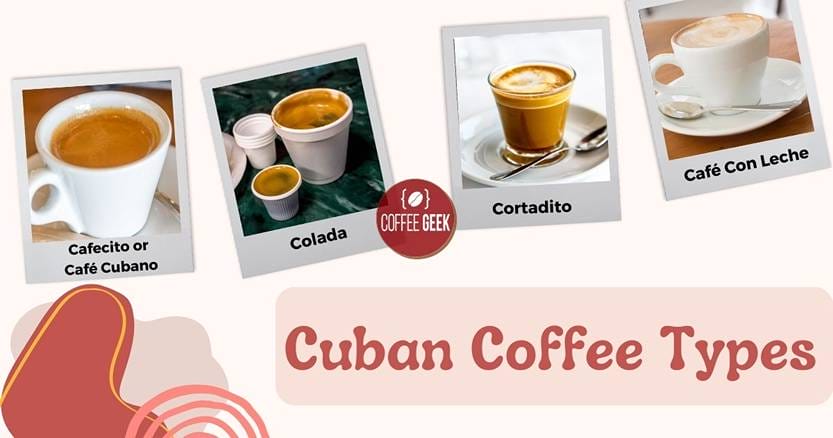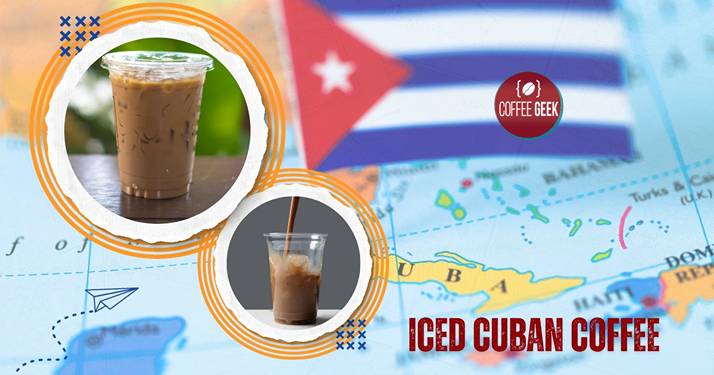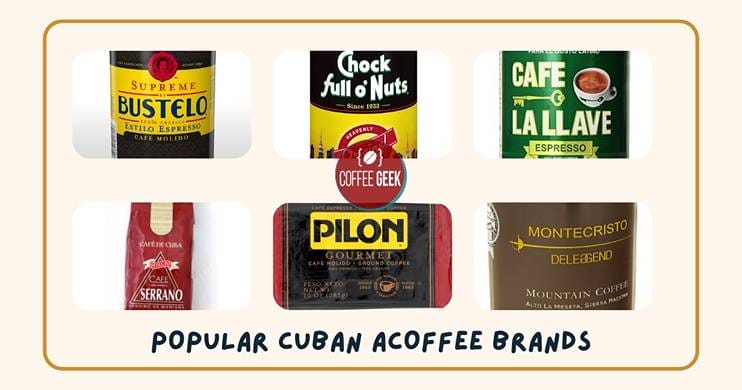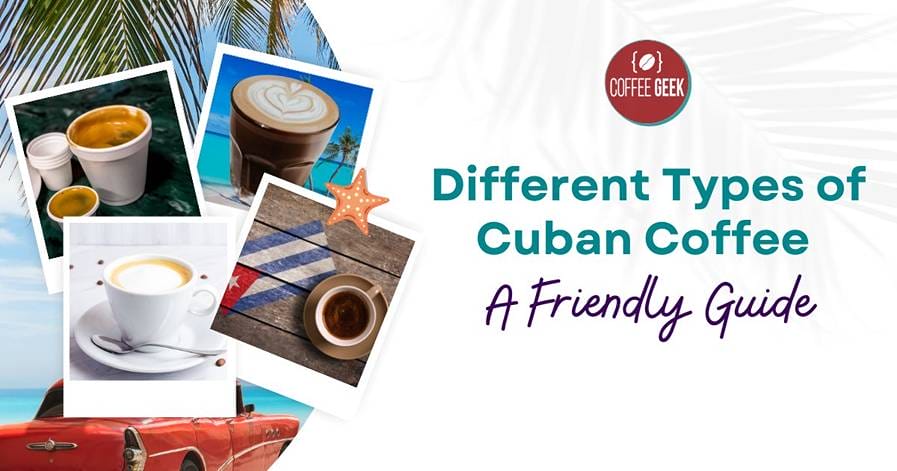Cuban coffee is a symbol of warmth and connection, with rich flavors that have garnered fans all over the world.
The distinct taste of Cuban coffee begins with its roots steeped in Cuban Coffees culture, blending together tradition and modernity through an array of brewing techniques and coffee types.
The expertise of coffee preparation has been passed down through generations, allowing people today to experience the delightful infusions native to Cuba in a variety of ways.

As you venture into the world of Cuban coffee, you’ll discover not just the unique brewing process that gives it its signature boldness, but also the different types of coffee like the Cafecito and the Cortadito.
And with the ever-growing popularity of Cuban coffee in Miami and across the United States, it’s easier than ever to indulge in this flavorful and invigorating experience and enjoy different types of Cuban coffee.
Key Takeaways
Cuban coffee is deeply rooted in culture and tradition, offering an array of unique brewing methods and flavors.
The different types, such as the Cafecito and Cortadito, each provide a distinct Cuban coffee experience.
Cuban coffee’s popularity has expanded in America, particularly in Miami, making it more accessible to enjoy.
Roots of Cuban Coffee Culture
You might be wondering where the rich Cuban coffee culture came from. Well, the heritage of Cuban coffee can be traced back to the middle of the 18th century when the locals began growing and drinking coffee in Cuba .
Cuban coffee beans are harvested mainly in two regions, Sierra Maestra and Escambray Mountains.
The high-quality beans, usually dark-roasted Arabica or a blend that includes robusta, are then finely ground to create the bold and robust flavor that Cuban coffee is known for.

When you sip a cup of Cuban coffee, you’re not just enjoying a delicious beverage, but you’re also savoring a piece of Cuban history that has withstood the test of time.
So, next time you’re in the mood for a coffee adventure with some added cultural depth, don’t hesitate to indulge yourself in the world of Cuban coffee.
The Brewing Process
To make a perfect Cuban coffee, you’ll need a few essential tools and techniques. The first step in creating your flavorful cup of Cuban coffee is selecting the right equipment.
A Moka pot or stovetop espresso maker is the go-to brewing method for achieving the authentic Cuban coffee experience.
Begin by filling the lower chamber of your Moka pot with water, up to the fill line. Next, add your favorite dark-roasted Cuban-style coffee grounds to the brew basket.
Make sure to use a fine grind for optimal extraction. Once everything is in place, assemble the Moka pot and place it on your stovetop over medium heat.
As the water heats up and creates pressure within the lower chamber, it will force itself through the coffee grounds and into the upper chamber, resulting in a strong, aromatic espresso.

Keep an eye on the brewing process and remove the Moka pot from the heat once the coffee reaches the top.
Now it’s time to create the signature espuma (foam). In a small, separate container, combine a small amount of brewed espresso with sugar, stirring vigorously.
The sugar will dissolve in the hot liquid, creating a thick, velvety foam. How much sugar you add depends on your taste preferences and the type of Cuban coffee you’re making.
Finally, pour the remaining brewed espresso into your serving cups and spoon the sweet espuma on top. The foam not only adds an element of sweetness but also gives your Cuban coffee its unique texture and visual appeal.
There you have it! By following these simple steps, you can easily recreate the authentic Cuban coffee experience in the comfort of your own home. Cheers to a well-brewed cup of Cuban coffee!
Different Types of Cuban Coffee
Cafecito or Café Cubano
Cafecito, also known as Café Cubano, is the Cuban version of espresso. This strong, sweet coffee is made by mixing finely ground dark roasted coffee with sugar before brewing.
While sipping your Cafecito, enjoy the slightly frothy layer called “espumita,” which forms on top due to the sugar.
Colada
Colada is another type of Cuban coffee that’s perfect for sharing with friends and family. Brewed the same way as a Cafecito, the Colada is serve in larger portions and usually comes with small cups for sharing.
When enjoying Colada, you’ll notice that the sugar makes it sweeter and less bitter than regular espresso—a delicious twist to brighten your day!

Cortadito
The Cortadito is your go-to choice when you’re in the mood for something creamy. This Cuban coffee is similar to a Cafecito but “cut” with a bit of warm milk.
The addition of milk makes it less intense than a straight shot of Cuban espresso, offering a more balanced flavor. It often uses demerara sugar for a unique sweetness profile.
Café Con Leche
If you’re a fan of lattes, Café Con Leche might become your new favorite! This Cuban coffee drink is made with equal parts espresso and hot or steamed milk, usually topped with a dollop of sweet condensed milk.
The silky texture and irresistible sweetness make Cafe Con Leche a delight perfect for starting your day or as an afternoon treat.
As you explore the world of Cuban coffee, be sure to try each of these delicious options. Each type offers its unique flavors and experiences, making them perfect for different moods and occasions.
Enjoy the rich history and culture behind these Cuban coffee drinks as you savor every sip!
Iced Cuban Coffee
If you’re looking for a refreshing twist on traditional Cuban coffee, why not try making an iced Cuban coffee?
This delicious and invigorating beverage is perfect for hot summer days, and it brings together the rich and sweet flavors of Cuban coffee with the cooling sensation of ice.
To make your own iced Cuban coffee, start by brewing a strong cup of Cuban coffee using a Moka pot or espresso machine. The main ingredient should be finely ground espresso or dark roast coffee beans.
Fill the bottom chamber of your Moka pot with water up to the fill line, add the coffee grounds, and heat it to brew your coffee.
While your coffee is brewing, prepare the sweetener. This can be done by adding 1-2 tablespoons of sugar (adjust according to your taste) into a mixing glass or cup.

When the coffee is ready, pour it over the sugar, and stir until the sugar dissolves completely. This mixture will give your iced Cuban coffee the distinctive sweetness that sets it apart from other iced coffee drinks.
Now it’s time to add ice to your coffee. Fill a tall glass with ice cubes, then pour your sweetened coffee over the ice. You can also experiment with crushed ice if you prefer a slightly different texture.
Don’t worry if your coffee seems to be too strong at first, as the ice will dilute it a bit as it melts.
Finally, complete your iced Cuban coffee by adding creamer or milk.
This step is optional, but it can add a delicious creaminess to your drink. You can use regular milk, half-and-half, or even a non-dairy milk like almond or coconut milk, depending on your personal preferences.
And there you have it–your very own iced Cuban coffee to enjoy on a warm day! So go ahead, treat yourself to this delightful beverage, and experience the unique, friendly flavors of Cuban culture in a glass.
Cuban Coffee in Miami and America
As you explore the world of Cuban coffee, you’ll find that Miami is the perfect place to begin your journey.
The influence of Cuban Coffee culture is evident in Miami’s thriving Cuban coffee scene, which offers various types to satisfy coffee lovers.
In Miami, you’ll come across the four main types of Cuban coffee: cafecito, colada, cortadito, and café con leche. Each of these coffee types caters to different tastes and preferences.
While the cafecito is a strong, single shot of Cuban espresso, the cortado is a milder version, mixed with a small amount of steamed milk.
On the other hand, colada is a larger, more shareable serving of cafecito, typically enjoyed with friends and family. Finally, the café con leche is an indulgent combination of strong Cuban coffee and warm steamed milk.

Miami is home to numerous Cuban coffee shops where you can grab a delicious and authentic cup, such as Old’s Havana Cuban Bar & Cocina, Mas Cuba Cafe, and Cortadito Coffee House.
Of course, if you’re outside of Miami, America has other cities with thriving Cuban coffee scenes. Be sure to visit cities with significant Cuban populations, such as New York City, Los Angeles, and Tampa, to find authentic Cuban cafes and delicious cups of coffee.
In summary, whether you’re in Miami or any other city in America, you can discover the delicious world of Cuban coffee. Remember to try out the four different types of Cuban coffee: cafecito, colada, cortadito, and café con leche.
Don’t hesitate to stop by a local Cuban cafe to enjoy the rich flavors and experience the warmth of the Cuban coffee culture.
Popular Cuban Coffee Brands
When exploring Cuban coffee, you’ll discover a variety of brands that offer rich and flavorful options. Here are some of the most popular Cuban coffee brands for you to consider trying:
Café Bustelo: Known for its bold and robust flavor, Café Bustelo Supreme is a classic choice when it comes to Cuban coffee.
This dark roast is perfect for any espresso shot brewing method, making it a versatile option for your morning cup of coffee.
Serrano: Another well-known Cuban coffee brand is Serrano. They offer high-quality beans that produce a smooth and delicious cup of coffee. You can find Serrano coffee on various online platforms, making it easily accessible.
Café La Llave: With its rich taste and intense aroma, Café La Llave is a favorite among Cuban coffee aficionados. This well-established brand prides itself on its traditional methods and high-quality beans.
Montecristo Turquino Montanes: Named after the famous Cuban mountain, this brand offers a unique flavor profile.

Montecristo Turquino Montanes coffee is made from carefully selected beans that are cultivated high in the mountains, ensuring a high-quality and distinctive taste.
Pilon Gourmet: This brand is a great choice if you’re looking for an indulgent, gourmet Cuban coffee option. Pilon Gourmet sources their beans from some of the finest growing regions, resulting in a rich and flavorful brew.
Naviera Chock Full O’Nuts: Offering a blend of Cuban and American coffee traditions, Naviera Chock Full O’Nuts is a unique option for those looking for something different. This brand combines bold and smooth flavors for a satisfying coffee experience.
Don’t forget that you can find some of these Cuban coffee brands on Amazon for convenient online shopping. Enjoy exploring these popular options and discovering your favorite Cuban coffee brand!
| Coffee Type | Description |
|---|---|
| Café Cubano | Strong, sweet espresso shot made with demerara sugar. Also known as Cuban espresso or Cuban shot. |
| Café con Leche | Cuban espresso with steamed milk, creating a balanced and creamy coffee. |
| Cortadito | Similar to a Café Cubano but with a small amount of warm milk, offering a smoother taste. |
| Colada | Strong Cuban coffee meant for sharing, served in small cups for multiple people. |
| Café Bonbon | A sweet treat with condensed milk added to the Café Cubano, creating a layered and rich flavor. |
| Café Americano | Diluted Café Cubano with additional hot water for a milder taste. |
| Serrano | Espresso served with a slice of lime, providing a citrusy twist to the coffee experience. |
| Guarapo | Espresso mixed with sugar cane juice, offering a unique and refreshing flavor. |
| Café de Olla | Traditional Cuban spiced coffee brewed with cinnamon and sometimes anise. |
| Café Bombón | A sweet coffee made with condensed milk and served in a glass. |
Cuban Coffee and Pairings
When it comes to enhancing your Cuban coffee experience, finding the perfect pairing can take your enjoyment to a whole new level.
As a coffee lover or a barista yourself, you’re already familiar with the delightful taste of Cuban coffee in its various forms like Cafecito, Café Cubano, Café con Leche, and Cortadito.
One iconic pairing for Cuban coffee is the Cuban cigar, which has a strong presence in the world of luxury experiences.
Enjoying a fine Cuban cigar alongside your coffee can be both a novel and relaxing way to appreciate the rich and bold flavors of both.
The strong, sweet taste of Cuban coffee complements the smooth, rich aroma of a cigar and intensifies the sensory experience.
As a coffee aficionado, experimenting with various food pairings can also elevate your Cuban coffee moments. Sweet treats like Cuban pastries and desserts add a new dimension to the strong, intense flavors.
For the famous Café con Leche, pairing it with warm, buttery toasted Cuban bread or flaky pastelitos can enhance your overall enjoyment and satisfy your taste buds.
If you prefer a lighter option, consider pairing your Cortadito with fresh fruit, traditional Cuban turrones (nougat) or guava jelly. To bring your coffee experience full circle, try incorporating flavors from different regions of Cuba.
For example, pair a Café Cubano with a fruity truffle or chocolate pairing, which can highlight the sweetness while offering a new depth of flavor.
Always remember that discovering the perfect pairing is an individual journey. Experiment with your own creative combinations to find the pairings that make your Cuban coffee experience unique and enjoyable.
Embrace the friendly, communal aspect of coffee culture by sharing your coffee and cigar moments with friends and family.
Conclusion
Cuban coffee is an integral part of the culture in places like Havana, Coral Gables, and Miami, where the act of ordering coffee is as much a social activity as it is a caffeine fix.
There are several different types of Cuban coffees, each with its own recipe and cultural significance.
Frequently Asked Questions
What is the difference between Cafecito and Cortadito?
Cafecito is a strong, sweet espresso that is often enjoyed as a quick pick-me-up. It is typically served in small cups and is made with sugar.
On the other hand, Cortadito is a type of Cuban coffee where the espresso is “cut” with a small amount of warm milk.
This creates a more balanced coffee option, making it slightly softer and less intense than a straight-up Cafecito.
How do you make a Colada-style Cuban coffee?
To make a Colada-style Cuban coffee, you’ll need to start with a strong espresso, usually a Cafecito. You’ll then pour the espresso into a larger container, like a Styrofoam cup, and add sugar to taste.
The key to a proper Colada is sharing it with others. It traditionally comes with small cups for divvying up the coffee among friends or coworkers. Colada is known for its sweet and intense flavor, perfect for sipping and socializing.
Where can I find authentic Cuban coffee near me?
In order to find authentic Cuban coffee near you, try checking out local coffee shops, cafés, or restaurants that specialize in Latin American cuisine.
There are also many online retailers that sell Cuban coffee beans so that you can make your own authentic brews at home. Don’t forget to ask friends or local communities for recommendations, as they may have favorite spots of their own.
What sets Cortadito coffee apart from other types?
Cortadito coffee is unique in that it takes the bold and intense flavors of traditional Cuban coffee and softens them ever so slightly with a bit of warm milk.
This small addition transforms the beverage into a lovely marriage of espresso and milk. Unlike a latte or cappuccino, which typically have more milk content, the Cortadito retains a bolder coffee profile while still offering a touch of creaminess.
How does Colada coffee compare to traditional Cuban coffee?
Colada coffee is a variation of traditional Cuban coffee that is meant for sharing. While both Cafecito and Colada coffee are made using strong espresso and sugar, a Colada is served in a larger container and enjoyed amongst friends or coworkers.
The essence of the Colada coffee experience is its communal aspect, and it showcases Cuban coffee culture’s strong emphasis on togetherness.
What makes Cuban espresso strong and distinct?
Cuban coffee’s unique strength and distinct taste come from the brewing technique as well as the use of sugar.
Using an espresso-type machine called a cafetera, or a Moka pot, Cuban coffee is brewed at a higher pressure than drip coffee. This results in a concentrated and bold flavor profile.
Adding sugar during the brewing process also contributes to its distinct taste by creating a sweet and frothy layer known as espuma, enhancing the overall coffee experience.

